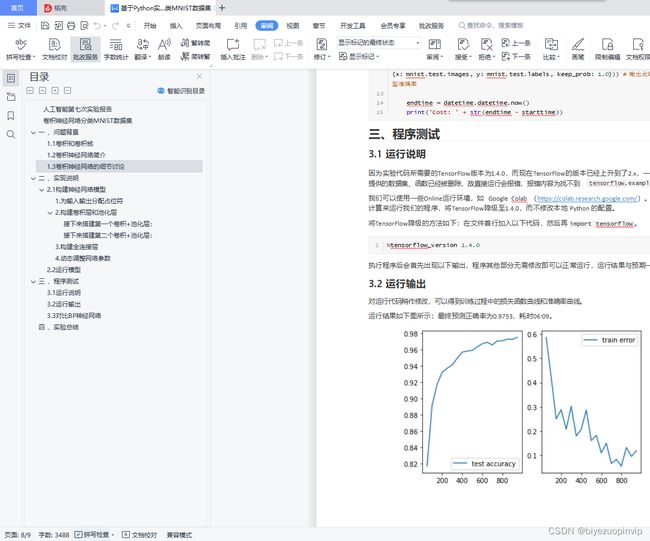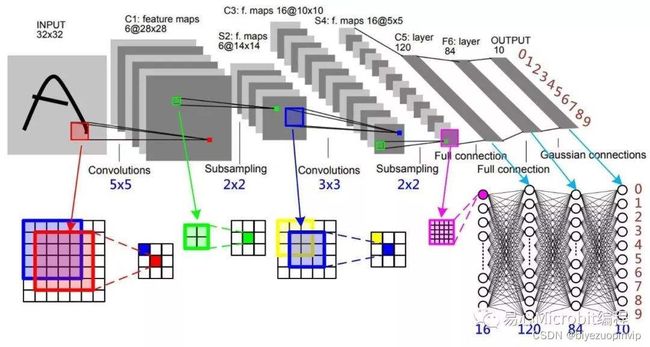基于Python实现的卷积神经网络分类MNIST数据集
卷积神经网络分类MNIST数据集
目录
人工智能第七次实验报告 1
卷积神经网络分类MNIST数据集 1
一 、问题背景 1
1.1 卷积和卷积核 1
1.2 卷积神经网络简介 2
1.3 卷积神经网络的细节讨论 3
二 、实现说明 3
2.1 构建神经网络模型 3
- 为输入输出分配占位符 3
- 构建卷积层和池化层 4
- 构建全连接层 5
- 动态调整网络参数 6
2.2 运行模型 6
三 、程序测试 7
3.1 运行说明 7
3.2 运行输出 7
3.3 对比BP神经网络 8
四 、实验总结 8
1.2卷积神经网络简介
卷积神经网络(CNN,Convolutional Neural Network)是一个多层的神经网络,每层由多个二维平面组成,每个平面由多个独立神经元组成。卷积神经网络中C层和S层,C层为特征提取层,也称为卷 积层,是卷积神经网络的核心,S层位特征映射层,也称为下采样层。
在卷积层,卷积神经网络利用卷积核对图像进行滤波,可以得到显著的边缘特性。在卷积神经网络 中,每一个就卷积层都紧跟着一个下采样层,卷积层负责探测上一层特征的局部连接,下采样层负责把 相似的特征合并起来。下采样层合并相似特征的过程降低了特征图的空间分辨率,达到了数据降维的效 果。
在卷积神经网络中,输入矩阵通过卷积过程形成卷积层,卷积结果在通过下采样过程形成规模减小 的特征映射矩阵。卷积过程用一个可训练的滤波器去卷积一个输入特征矩阵,加上一个偏置后得到卷积 层。下采样过程将邻域内若干的像素通过池化操作变为一个像素,经过加权和增加偏置后,通过一个激 活函数,产生一个缩小的特征映射图。
一般卷积神经网络除了卷积层和下采样层之外,还会在输出段加入全连接层,全连接层的输入就是 每一个深度最终特征提取的结果,全连接神经网络最后再对这些结果进行分类。
1.3卷积神经网络的细节讨论
神经元的空间排列:
与常规神经网络不同,卷积神经网络的各层中的神经元是三维排列的:宽度、高度和深度。宽 度和高度与特征图的宽高一一对应。
而深度本身是卷积神经网络的一个超参数,在数值上等于使用的滤波器的数量,而每个滤波器 是不一样的,在输入数据中寻找的特征。本文转载自http://www.biyezuopin.vip/onews.asp?id=16722从上一张卷积神经网络图上可以看到,卷积神经网络结构 的最后部分将会把全尺寸的图像压缩为包含分类评分的一个向量,向量是在深度方向排列的。
局部连接:
与局部连接相反的是全局连接,对应到一个全连接的神经网络。对于图像数据,因为像素的数 量过多,全连接神经网络需要非常多的的参数,这对于算法效率是难以接受的,故使用局部连接的 思路:每个神经元只对局部进行感知,即层中的神经元将只与前一层中的一小块区域连接,然后再 更高层汇总来得到全局信息。
局部连接的空间大小叫做神经元的感受野,感受野的大小与滤波器的空间尺寸相等。权值共享:
每个神经元参数设为相同,即权值共享,也即在同一深度上,每个神经元用同一个卷积核去卷 积图像。
池化:
计算图像一个区域上的某个特定特征的平均值(或最大值),这种聚合操作就叫做池化 (平均池化/最大池化)。使用池化可以很好的实现数据降维并防止过度拟合。
通常在连续的卷积层之间会周期性地插入一个池化层。它的作用是逐渐降低数据体的空间尺 寸,这样的话就能减少网络中参数的数量。汇聚层使用最大池化操作,对输入数据体的每一个深度 切片独立进行操作,改变它的空间尺寸。最常见的形式是汇聚层使用尺寸2x2的滤波器,以步长为2 来对每个深度切片进行降采样,将其中75%的激活信息都丢掉。
二 、实现说明
2.1构建神经网络模型
所构建的网络模型:卷积层 + 池化层 + 卷积层 + 池化层 + 全连接层 + 全连接层
from matplotlib import pyplot as plt
import tensorflow as tf
import datetime
from tensorflow.examples.tutorials.mnist import input_data
def weight_variable(shape): # 权重正态分布初始化
initial = tf.truncated_normal(shape, stddev=0.1) # shape表示生成张量的维度,mean是均值,stddev是标准差
return tf.Variable(initial)
def bias_variable(shape): # 偏置量初始化
initial = tf.constant(0.1, shape=shape) # value=0.1,shape是生成的维度
return tf.Variable(initial)
def conv2d(x, W): # 定义2维的卷积图层
return tf.nn.conv2d(x, W, strides=[1, 1, 1, 1], padding='SAME')
# strides:每跨多少步抽取信息,strides[1, x_movement,y_movement, 1], [0]和strides[3]必须为1
# padding:边距处理,“SAME”表示输出图层和输入图层大小保持不变,设置为“VALID”时表示舍弃多余边距(丢失信息)
def max_pool(x):
return tf.nn.max_pool(x, ksize=[1, 2, 2, 1], strides=[1, 2, 2, 1], padding='SAME')
# ksize 池化窗口的大小一般是[1, height, width, 1],所以这两个维度设为了1
# strides 和卷积类似,窗口在每一个维度上滑动的步长,一般也是[1, stride,stride, 1]
if __name__ == '__main__':
x = tf.placeholder(tf.float32, [None, 784])
y = tf.placeholder(tf.float32, [None, 10])
keep_prob = tf.placeholder(tf.float32)
# 创建神经网络第1层,输入层,激活函数为relu
W_layer1 = weight_variable([784, 500])
b_layer1 = bias_variable([500])
h1 = tf.add(tf.matmul(x, W_layer1), b_layer1)
h1 = tf.nn.relu(h1)
# 创建神经网络第2层,隐藏层,激活函数为relu
W_layer2 = weight_variable([500, 1000])
b_layer2 = bias_variable([1000])
h2 = tf.add(tf.matmul(h1, W_layer2), b_layer2)
h2 = tf.nn.relu(h2)
# 创建神经网络第3层,隐藏层,激活函数为relu
W_layer3 = weight_variable([1000, 300])
b_layer3 = bias_variable([300])
h3 = tf.add(tf.matmul(h2, W_layer3), b_layer3)
h3 = tf.nn.relu(h3)
# 创建神经网络第4层,输出层,激活函数为softmax
W_layer4 = weight_variable([300, 10])
b_layer4 = bias_variable([10])
predict = tf.add(tf.matmul(h3, W_layer4), b_layer4)
y_conv = tf.nn.softmax(tf.matmul(h3, W_layer4) + b_layer4)
cross_entropy = tf.reduce_mean(tf.nn.softmax_cross_entropy_with_logits(logits=predict, labels=y))
train_step = tf.train.AdamOptimizer(1e-4).minimize(cross_entropy)
correct_prediction = tf.equal(tf.argmax(y_conv, 1), tf.argmax(y, 1))
accuracy = tf.reduce_mean(tf.cast(correct_prediction, 'float'))
i_list2 = []
train_error2 = []
test_acc2 = []
with tf.Session() as sess2:
sess2.run(tf.global_variables_initializer()) # 初始化变量
starttime = datetime.datetime.now()
mnist = input_data.read_data_sets('MNIST_data/', one_hot=True)
for i in range(1000):
batch = mnist.train.next_batch(100)
if i % 50 == 0:
cross_entropy_now = sess2.run(cross_entropy, feed_dict={x: batch[0], y: batch[1], keep_prob: 1})
print('step %d, training error %g' % (i, cross_entropy_now))
res = accuracy.eval(session=sess2,
feed_dict={x: mnist.test.images, y: mnist.test.labels, keep_prob: 1.0})
print('test accuracy %g' % res)
if i != 0:
i_list2.append(i)
train_error2.append(cross_entropy_now)
test_acc2.append(res)
sess2.run(train_step, feed_dict={x: batch[0], y: batch[1], keep_prob: 0.8})
endtime = datetime.datetime.now()
print('Cost: ' + str(endtime - starttime))
x = tf.placeholder(tf.float32, [None, 784])
# 输入数据 None表示行不定
x_image = tf.reshape(x, [-1, 28, 28, 1])
# 将原图reshape为4维,-1表示数据是黑白的,28*28=784,1表示颜色通道数目
y = tf.placeholder(tf.float32, [None, 10])
W_conv1 = weight_variable([5, 5, 1, 32])
# 按照[5,5,输入通道=1,输出通道=32]生成一组随机变量
b_conv1 = bias_variable([32])
h_conv1 = tf.nn.relu(conv2d(x_image, W_conv1) + b_conv1)
# 输出size 28*28*32(因为conv2d()中x和y步长都为1,边距保持不变)
h_pool1 = max_pool(h_conv1)
# 把h_pool1的厚度由32增加到64,长宽由14*14缩小为7*7
W_conv2 = weight_variable([5, 5, 32, 64])
b_conv2 = bias_variable([64])
h_conv2 = tf.nn.relu(conv2d(h_pool1, W_conv2) + b_conv2)
h_pool2 = max_pool(h_conv2)
# 第一层全连接
# 把h_pool2由7*7*64,变成1024*1
W_fc1 = weight_variable([7 * 7 * 64, 1024])
b_fc1 = bias_variable([1024])
h_pool2_flat = tf.reshape(h_pool2, [-1, 7 * 7 * 64])
# 把pooling后的结构reshape为一维向量
h_fc1 = tf.nn.relu(tf.matmul(h_pool2_flat, W_fc1) + b_fc1)
keep_prob = tf.placeholder(tf.float32)
h_fc1_drop = tf.nn.dropout(h_fc1, keep_prob)
# 第二层全连接
# 按照keep_prob的概率扔掉一些,为了减少过拟合
W_fc2 = weight_variable([1024, 10])
b_fc2 = bias_variable([10])
predict = tf.add(tf.matmul(h_fc1_drop, W_fc2), b_fc2)
y_conv = tf.nn.softmax(tf.matmul(h_fc1_drop, W_fc2) + b_fc2)
cross_entropy = tf.reduce_mean(tf.nn.softmax_cross_entropy_with_logits(logits=predict, labels=y)) # 计算误差
train_step = tf.train.AdamOptimizer(1e-4).minimize(cross_entropy) # 通过使用动量(参数的移动平均数)来改善传统梯度下降,促进超参数动态调整
correct_prediction = tf.equal(tf.argmax(y_conv, 1), tf.argmax(y, 1)) # 找出预测正确的标签
accuracy = tf.reduce_mean(tf.cast(correct_prediction, 'float')) # 得出通过正确个数除以总数得出准确率
i_list = []
train_error = []
test_acc = []
with tf.Session() as sess:
sess.run(tf.global_variables_initializer()) # 初始化变量
starttime = datetime.datetime.now()
mnist = input_data.read_data_sets('MNIST_data/', one_hot=True)
for i in range(1000):
batch = mnist.train.next_batch(100)
if i % 50 == 0:
cross_entropy_now = sess.run(cross_entropy, feed_dict={x: batch[0], y: batch[1], keep_prob: 1})
print('step %d, training error %g' % (i, cross_entropy_now))
res = accuracy.eval(session=sess,
feed_dict={x: mnist.test.images, y: mnist.test.labels, keep_prob: 1.0})
print('test accuracy %g' % res)
if i != 0:
i_list.append(i)
train_error.append(cross_entropy_now)
test_acc.append(res)
sess.run(train_step, feed_dict={x: batch[0], y: batch[1], keep_prob: 0.8})
endtime = datetime.datetime.now()
print('Cost: ' + str(endtime - starttime))
ax1 = plt.subplot(121)
ax1.plot(i_list, test_acc, 'b', label="CNN")
ax1.plot(i_list, test_acc2, 'g', label="BP")
ax1.set_title("test accuracy")
plt.legend()
ax2 = plt.subplot(122)
ax2.set_title("training error")
ax2.plot(i_list, train_error, 'b', label="CNN")
ax2.plot(i_list, train_error2, 'g', label="BP")
plt.legend()
plt.show()







